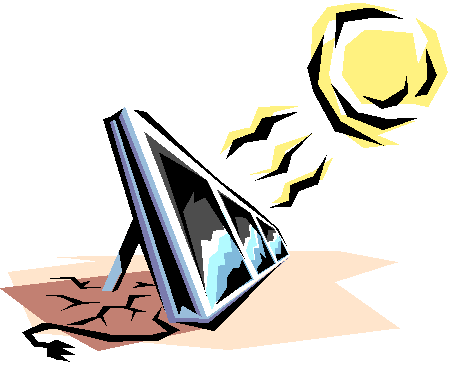 |
ecosystems solar Wholesale Solar Thermal Distributors since 1988
|
|
|
QUICK CONNECTS (click on following headings for immediate connection to page) |
||

| |||||||||
|
|
Designing a Solar Pool Heating System The main design consideration is to have sufficient solar panel surface area to transfer enough heat to the pool during the day to offset overnight heat losses and thus steadily increase the poolís temperature. Key elements of a properly designed system:
To be more specific, solar heating an in-ground pool is most dependent on pool size (surface area) and local climate. Every geographic area requires somewhat different solar system sizing to offset heat loss from the surface area of the pool. Recommended solar sizing varies from 50% of your pools surface area in sunnier areas to 70% in more cloudy environments like west of the Cascades. In Hawaii, since solar heat is needed only during the fall and winter when solar radiation is reduced, sizing is 80-100% of the pool's surface there. To figure your pool's surface area, use these formulas. Once you determine your pools surface area and recommended solar sizing for your location, the next step is figuring how many solar panels you need. For example, if your pool was 450 square feet and you lived in a 70% recommended area, your solar system would need to be 315 square feet. Now you need to determine panel location. Panels should face somewhere along an arc from SE to due West or compass reading 135-270o magnetic. It is important to use a compass if unsure. Be aware of your magnetic declination, the degree difference between magnetic and true South. For the NW, this varies from 17E to 22E and is 11E for Hawaii (see declination map). For example, the declination for Portland, OR is 21o E. Magnetic south on a compass is 180o, but true south is actually 159o. Ideally, due to warmer ambient temperatures, S to SW is often best. Less than favorable orientation can usually be offset by increased solar surface area. Avoid areas of shade between 10am-4pm. Flat roofs, or any shallow pitched surface less than 6o, should be avoided unless in Hawaii. Panels need to drain to avoid potential freeze damage when not in use over the winter and need a minimum 6o pitch to self-drain. Freeze damage to panels is NOT covered under FAFCO panel warranty. If installing the solar system flat is the only option, we would recommend another system that is made of a more flexible EPDM material that can handle some freezing conditions. However, the material is not as durable as FAFCO's Contact us in such a case. Most systems are installed on roofs since this is up out of harms way and usually free from most shading (see installation photos above). If you don't have available roof space in the necessary orientation, have shade problems, or simply don't want to use your roof, panels can also be installed on panel racks. Panels come in 4x8, 4x10, and 4x12 feet. The headers are actually 51" long. Measure the space you are considering for panels. Always use the largest pool panels you can fit since this reduces mounting hardware requirements. For example, seven 4x12' panels is 336 square feet, eight 4x10s is 320. More panel surface area is always better than less. Solar controls are also recommended for any system to achieve maximum performance. As far as we are concerned, they are a requirement on systems west of the Cascades and Hawaii for sure. Controls automatically monitor the solar system to operate only when it can add heat to the pool using very accurate thermister sun and water sensors to achieve maximum efficiency. Money well spent! Remember, solar panels will evacuate heat too if the pool water is warmer than the ambient air. Thus, you typically don't want systems running at night unless the pool is too warm and you wish to cool it down. Controls simply eliminate human error in system monitoring. A pool cover is always recommended to reduce overnight losses especially in windy or dry areas where evaporation is high. Any cover works to reduce evaporation and thus heat loss and can help any solar system perform better. The use of a cover can often allow you to reduce the recommended solar sizing and still get "swimable" water temperatures. These system are simple in design and easy to install. You can save money on contractor labor by doing it yourself. Consider self-installation. Check out our Self-install Program under Services. For installation information, check individual panel types. Installation procedure is the same for both SunSaver and REVOLUTION and similar for SunSaver ST.
LET US HELP! -- System Design Assistance ecosystems will design or help design any solar system for you. Depending on whether the system is residential or commercial, we will charge a one-time flat fee of $50 or $100. This fee can apply towards any system components purchased through one of our dealers. In other words, if you want us to design a system for you but you do not buy any components through one of our dealers, we will have to charge you for this service. We apply this credit to the wholesale price charged to our dealer, so it saves you even more money. How it works ecosystems is interested in assisting whenever and where ever possible to ensure systems are designed properly. Proper design is directly proportional to system performance and owner satisfaction. This one if the serious oversights by many installers and product dealers. The only way we can help determine system sizing is to know:
Fill out one of our design questionnaires and get the information to us.
Key Benefits of proper system design
Our Capabilities
Copyright © 2001
ecosystems. All rights reserved. |
|
|